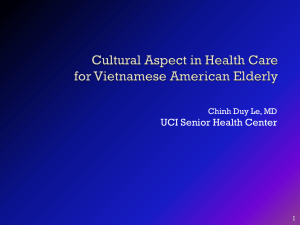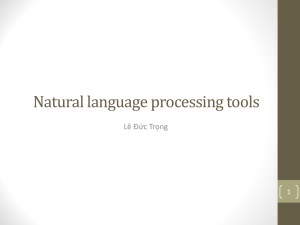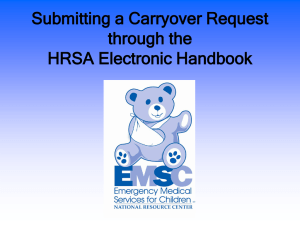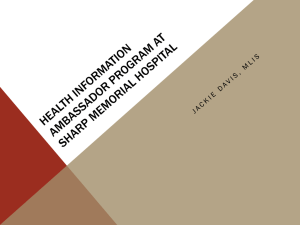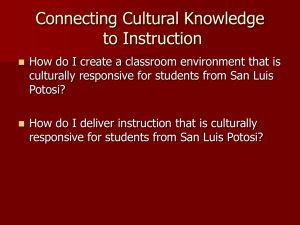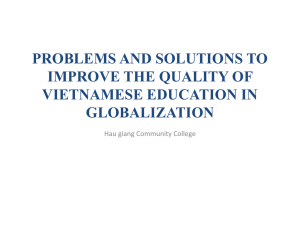The Vietnamese Culture.
advertisement
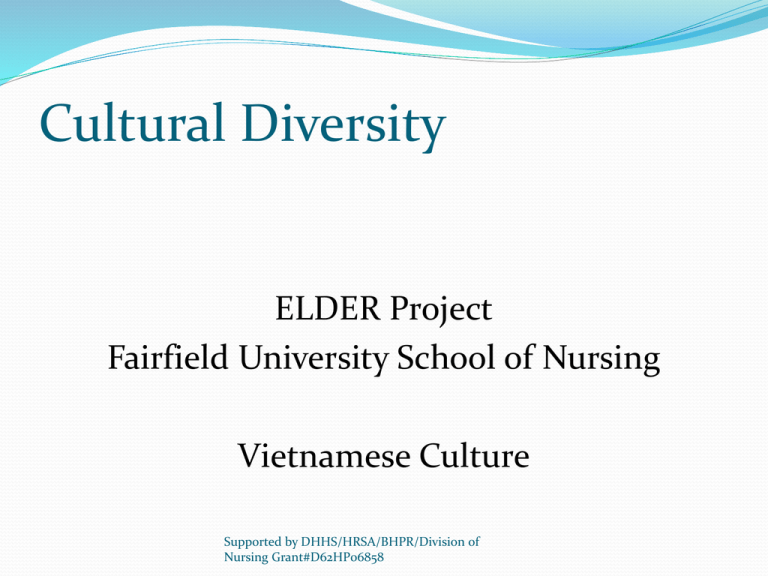
Cultural Diversity ELDER Project Fairfield University School of Nursing Vietnamese Culture Supported by DHHS/HRSA/BHPR/Division of Nursing Grant#D62HP06858 Vietnamese Culture Objectives: Upon completion of this session, the participants will be able to …. Discuss the role of religion, traditional health care beliefs, social values, and family structure of Vietnamese culture and the impact these factors have on health care. Identify specific culturally sensitive practices that can be incorporated into your work with Vietnamese patients and Vietnamese American patients. Supported by DHHS/HRSA/BHPR/Division of Nursing Grant#D62HP06858 Vietnamese Culture Introduction: The Vietnamese American community is growing, and as the first generation ages, younger generations multiply. Adaptation to a new way of life is accompanied by problems which are magnified for persons who are displaced from their natural culture and society. Second and third generation Vietnamese Americans deal with balancing pressures to assimilate to the dominant Western culture while meeting the demands of family or ethnic loyalty. Supported by DHHS/HRSA/BHPR/Division of Nursing Grant#D62HP06858 Vietnamese Culture Introduction: The conquest of Vietnam by France began in 1858 and was completed by 1884 and in 1887 became part of French Indochina. Vietnam declared independence after World War II, but France continued to rule until its 1954 defeat by Communist forces under Ho Chi Minh. Under the Geneva Accords of 1954, Vietnam was divided into the Communist North and anti-Communist South. US economic and military aid to South Vietnam grew through the 1960s in an attempt to bolster the government, but US armed forces were withdrawn following a cease-fire agreement in 1973. Two years later, North Vietnamese forces overran the South Supported by DHHS/HRSA/BHPR/Division of reuniting the country under Communist rule. Nursing Grant#D62HP06858 Supported by DHHS/HRSA/BHPR/Division of Nursing Grant#D62HP06858 Supported by DHHS/HRSA/BHPR/Division of Nursing Grant#D62HP06858 Vietnamese Culture Communication: The official language is Vietnamese. This is a tonal language in which meanings are determined by pitch or tone. Native language is spoken by about 80% in their own homes. Politeness is valued and may display indirectness and extreme politeness in dealing with others. Direct eye contact is avoided with others as a sign of respect. Those in authority are respected and thus the patient and family may not ask questions. Supported by DHHS/HRSA/BHPR/Division of Nursing Grant#D62HP06858 Vietnamese Culture Communication: Appointment times may not be taken literally thus arriving late so as not to appear overly enthusiastic. Shame is avoided; thus do not voice disagreements with others. The patient’s intentions or wishes may not be revealed that are in contrast to the physician’s wishes . Names are written in reverse order of American names; family name first, middle name and then first name. Supported by DHHS/HRSA/BHPR/Division of Nursing Grant#D62HP06858 Vietnamese Culture Family and Social Structure: Strong family ties exist. Elders are viewed as leaders in the family and have strong influence in decision making. Elders are highly respected and sought after for advice The Vietnamese are a patriarchal family with 2-4 generations and extended family living in the same house. The family and community have a strong sense of collective responsibility and mutual obligation. Supported by DHHS/HRSA/BHPR/Division of Nursing Grant#D62HP06858 Vietnamese Culture View of Illness: Illness is believed to be an unavoidable part of life. Illness is believed to be of organic or supernatural causes as well as external causes. Stoicism is highly respected and can prevent people from seeking care. Illness is thought to be attributed to: organic or physical problems, imbalance of yin and yang, obstruction of chi (life energy), failure to be in harmony with nature, punishment for immoral behavior or a curse. Supported by DHHS/HRSA/BHPR/Division of Nursing Grant#D62HP06858 Vietnamese Culture View of Illness: May be resistive to invasive procedures like surgery as they are believed to cause the soul to leave the body. A physician will be sought if it does not intrude on the body. Injections are believed to potentially hurt the spirit and may resist venipuncture as it is believed to upset the hot/cold balance. Some Asians believe they have a different physiologic constitution than white people. Western drugs are thought of as hot and too potent for use and as a result prescribed medication may not be taken. Supported by DHHS/HRSA/BHPR/Division of Nursing Grant#D62HP06858 Vietnamese Culture Folk Medicine: Practices vary between ethnic groups. Medicinal system is based on Chinese medicine. Living things are believed to be composed of 4 basic elements - air, fire, water and earth with associated characteristics of cold, hot, wet and dry. Hot/cold belief system is common to many Vietnamese regardless of their educational status or occupation. The pathway to good health is attained through traditional herbal remedies, tonics, massage and the avoidance of excess. Supported by DHHS/HRSA/BHPR/Division of Nursing Grant#D62HP06858 Vietnamese Culture Folk Medicine: Two main herbal traditions include Chinese herbal medicine and Vietnamese herbal medicine. Both believe illness results from humoral imbalance in the body. Herbals are believed to be more effective because they deal with the true causes of illness where biomedicine only treats the symptoms. Practice dermal abrasive procedures based on hot/cold physiology. Often used to treat cough, headache, nausea, backache and motion sickness. Cutaneous hematomas are made over the face, neck, anterior and posterior trunk to release excessive air. Supported by DHHS/HRSA/BHPR/Division of Nursing Grant#D62HP06858 Vietnamese Culture Folk Medicine: Moxibustion is used by some in which small circular superficial burns are made on the torso, head and neck. This often is combined with acupuncture and is widely used in Vietnam and the U.S. Mental illness is considered shameful, is feared and often denied. Many do not trust Western medicine and use it only as a last resort. Many use traditional remedies in parallel to Western healthcare. Supported by DHHS/HRSA/BHPR/Division of Nursing Grant#D62HP06858 Vietnamese Culture Dietary Habits: Rice is the basis of most Vietnamese meals. Rice noodle soup is one of the most popular breakfast and lunch foods. Traditional diet is mostly made up of rice, fish, pork, chicken and vegetables. Dairy and soy products are not part of the typical diet. Many are lactose intolerant and lack calcium. Diets are high in sodium and low in fiber from a lack of grains. Salty sauces are used for dipping food. Supported by DHHS/HRSA/BHPR/Division of Nursing Grant#D62HP06858 Vietnamese Culture Dietary Habits: Egg rolls are served with many meals and festive occasions. Tea is served from small tea pots with small cups to guests. Northern cuisine is known for its subtle flavors, central cuisine for its spiciness and southern cuisine for its sugar and bean sprouts. Chubby children are considered healthy and a sign of prosperity. Many Vietnamese are at risk for obesity, high cholesterol levels and diabetes. Supported by DHHS/HRSA/BHPR/Division of Nursing Grant#D62HP06858 Vietnamese Culture Time Orientation: Present oriented with strong links to the past. Religious Beliefs: A diversity of religions is practiced, which is continued as well in the U.S. Buddhism is the predominant religion and practiced by 90% of Vietnamese population. Human suffering is believed to come from cravings and desires which need to be eliminated in order to achieve spiritual enlightenment. Enlightenment is obtained through meditation. Supported by DHHS/HRSA/BHPR/Division of Nursing Grant#D62HP06858 Vietnamese Culture Religious Beliefs: Confucianism is also practiced and is more of a code of behavior than a religion. The emphasis is on filial piety and obligation, altruism and the belief that man creates his own destiny. Music, respect for authority and social rites is all very important. Taoism involves the worship of many gods. It values simplicity, patience, and contentment and strives for harmony between man and nature. Supported by DHHS/HRSA/BHPR/Division of Nursing Grant#D62HP06858 Vietnamese Culture Religious Beliefs: Confucianism and Taoism have strongly influenced cultural traditions. Many traditions are rooted in Confucianism, such as a respect for education, family and elders. Taoism desires avoidance of conflict and stoicism is a highly respected trait. 30 % of Vietnamese Americans (2 million) practice Catholicism. This is a remnant of Vietnam’s occupation by the French, Portuguese and Spanish. It is heavily influenced by Confucianism. Supported by DHHS/HRSA/BHPR/Division of Nursing Grant#D62HP06858 Vietnamese Culture Religious Beliefs: Older refugees in the U.S. practice animism, worship of spirits and natural forces. Ancestor worship is practiced in conjunction with their declared religions. Pictures of ancestors may be displayed on altar and incense is burned to pay tribute to them. Everyday items such as fruit, money, replicas of houses and vehicles are offered daily as the ancestors pass into a new life for their enjoyment. Supported by DHHS/HRSA/BHPR/Division of Nursing Grant#D62HP06858 Vietnamese Culture Holidays: Tet is Vietnamese New Year and is celebrated from January 9-February 20. It is a symbol of new beginnings and a time to pay debts, forgive others, improve self, and make friends out of enemies. This celebration has continued in the U.S. and includes gift giving like Christmas, door-to-door greeting like Halloween and a fresh start like New Years. What happens on that day is believed to be a forecast on how the rest of the year will go. Supported by DHHS/HRSA/BHPR/Division of Nursing Grant#D62HP06858 Vietnamese Culture Holidays: Trung Nguyen is Wandering Souls Day and is celebrated in the seventh month. Tables are filled with food offered to wandering souls of ancestors. Trung Thu is Mid-Autumn Festival, celebrated in the eighth month. Moon cakes are made out of sticky rice. Lanterns of different shapes are made and taken as people travel through the streets dancing. Supported by DHHS/HRSA/BHPR/Division of Nursing Grant#D62HP06858 Vietnamese Culture Conclusion: Maintaining Vietnamese traditions is a major concern in most Vietnamese American communities. Adult Vietnamese Americans often worry that their children may be loosing distinctive cultural characteristics. Some Vietnamese Americans have made a conscious effort to assimilate completely into American society but most retain their sense of ethnicity. Supported by DHHS/HRSA/BHPR/Division of Nursing Grant#D62HP06858 Reference Map of Southeast Asia Region. Retrieved on April 19th, 2010 from http://www.nationsonline.org/oneworld/map_of_southeast_asia.htm The World Factbook: Vietnam. Retrieved on April 18th, 2010 from https://www.cia.gov/library/publications/the-world-factbook/geos/vm.html University of Washington Medical Center. (2007). Communicating with Your Vietnamese Patient. Retrieved February 24, 2011 from http://depts.washington.edu/pfes/pdfs/vietnamesecultureclue.pdf University of Washington Medical Center. (2007). End of Life Care: The Vietnamese Culture. Retrieved February 24, 2011 from http://depts.washington.edu/pfes/pdfs/end%20of%20life%20carevietnamese.pdf Vietnamese Cultural Profile. Retrieved November 11, 2010 from http://ethnomed.org/culture/Vietnamese/Vietnamese-cultural-profile. Supported by DHHS/HRSA/BHPR/Division of Nursing Grant#D62HP06858 Power Point Presentation Created by: Joyce Cunneen, MSN, RN Fairfield University School of Nursing ELDER Project Education Coordinator Monica Starr, BSN, RN Fairfield University School of Nursing ELDER Project Program Coordinator Supported by DHHS/HRSA/BHPR/Division of Nursing Grant#D62HP06858
![vietnam[1].](http://s2.studylib.net/store/data/005329784_1-42b2e9fc4f7c73463c31fd4de82c4fa3-300x300.png)
